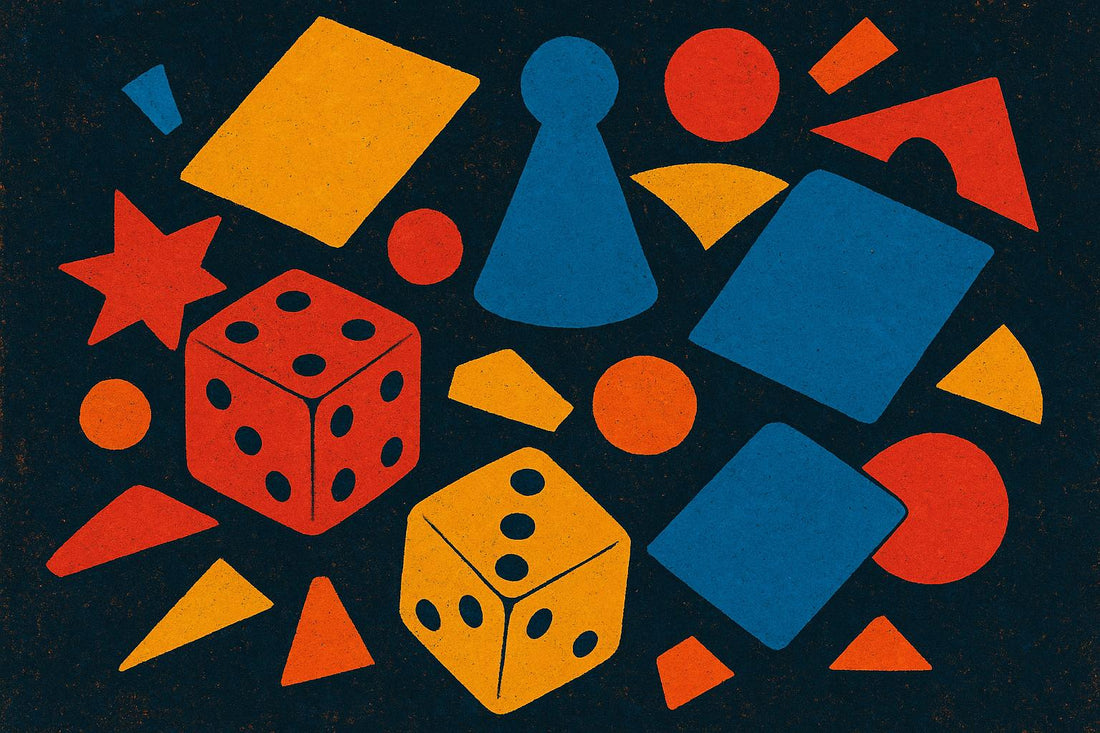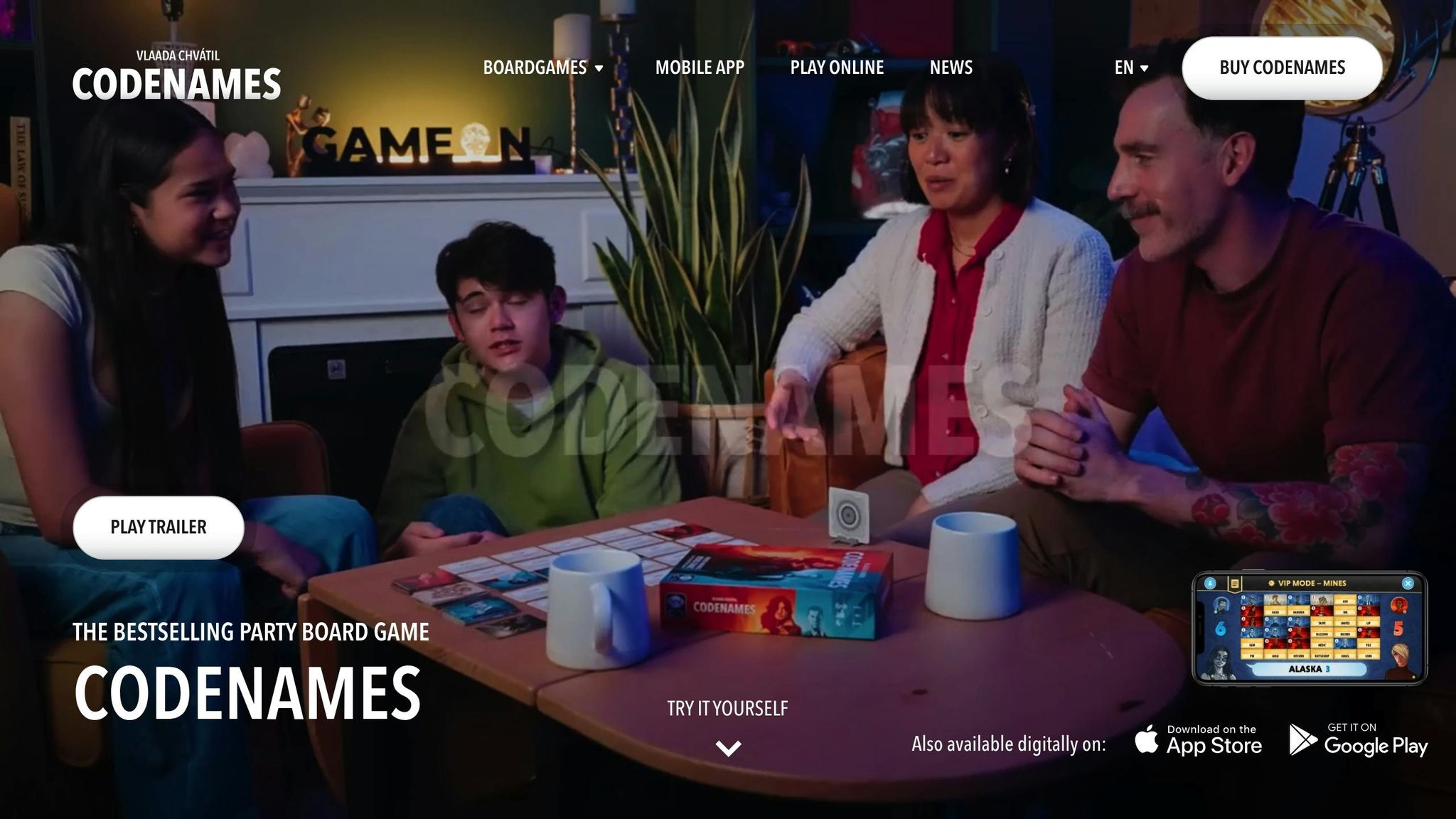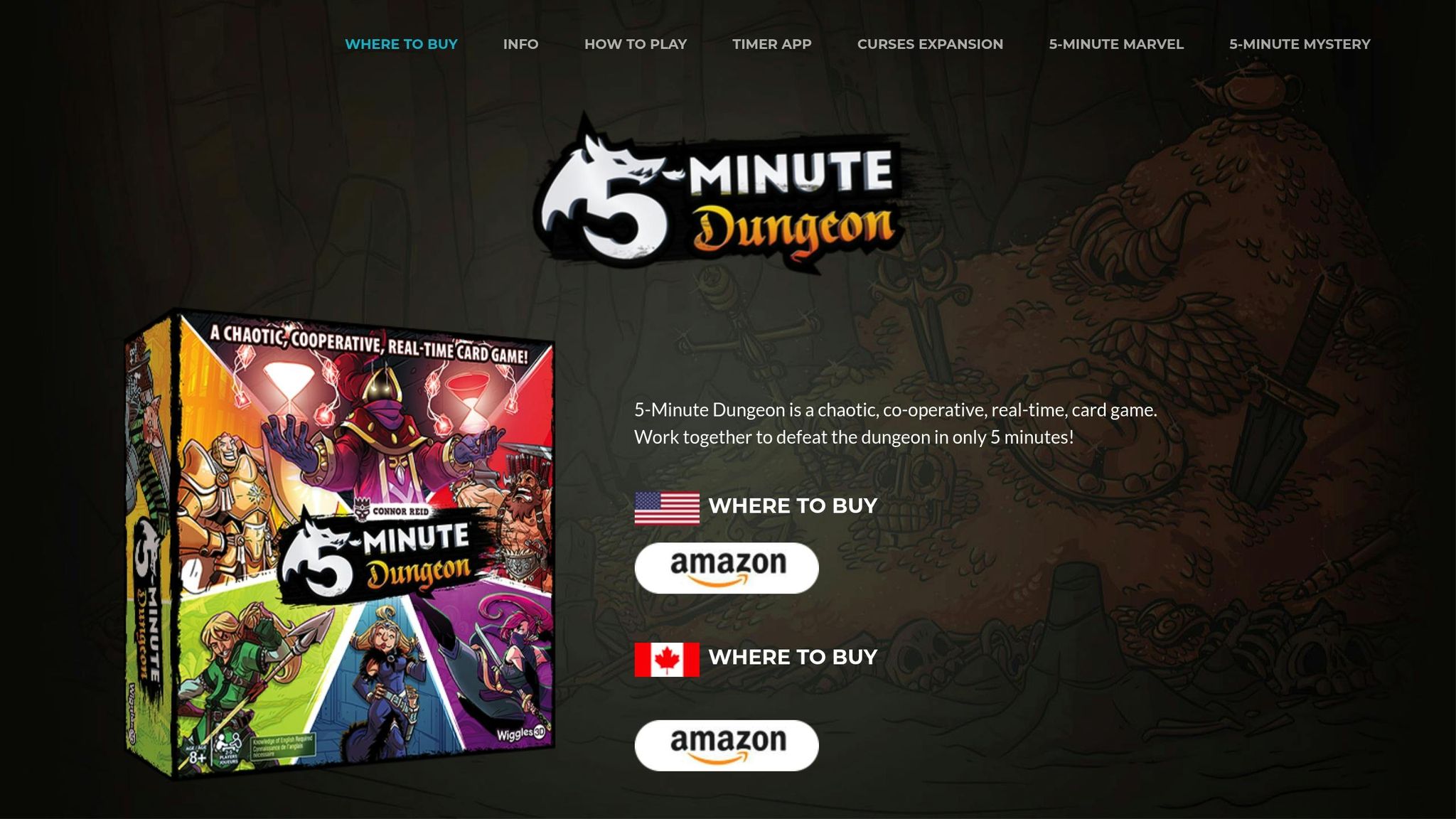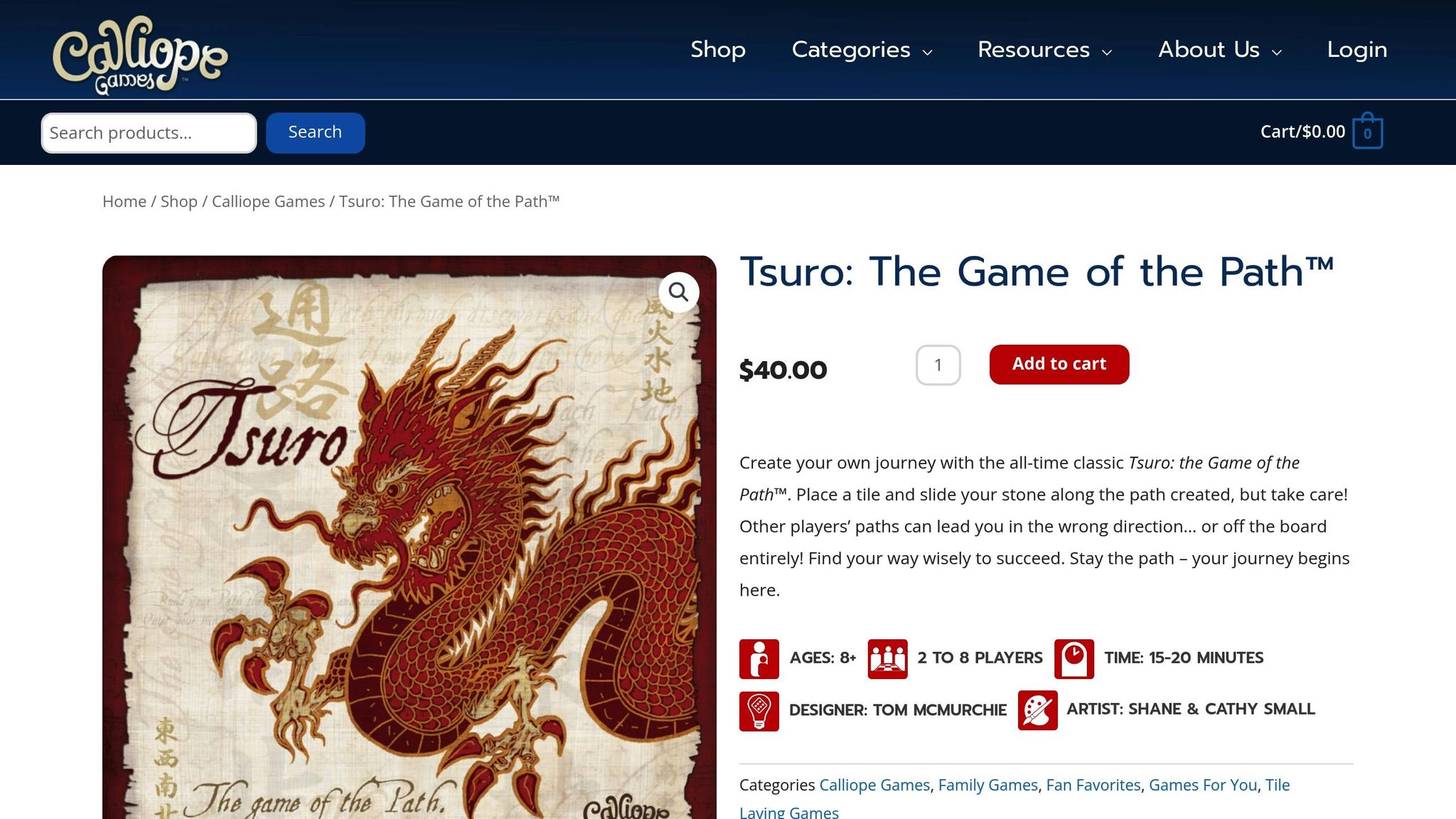Discover the Best Board Games for Every Player

Party Fever: Quick-Play Games for Instant Hilarity
Looking for party games that are easy to learn, quick to play, and packed with laughs? This guide covers eight top picks for gatherings of all sizes. These games are perfect for keeping energy high and ensuring everyone has a great time, whether you're hosting a family night or a lively party with friends. Here's a snapshot of what to expect:
- Chicken vs Hotdog: Lighthearted competition for 3-8 players, with rounds lasting 15-20 minutes.
- Sushi Go!: A card-drafting game for 2-5 players, blending strategy and chaos in 15-minute rounds.
- Codenames: A word association battle for 2-8+ players, ideal for team-based fun in 15-30 minutes.
- 5-Minute Dungeon: A frantic, cooperative card game for 1-5 players, where each round lasts just 5 minutes.
- So Clover!: A word clue game for 3-8 players, delivering laughs and teamwork in 30-minute sessions.
- Doodle Heist: A drawing and deduction game for 4-10 players, filled with unpredictable and funny moments.
- Tsuro: A tile-laying game for 2-8 players, combining strategy and quick rounds of 15-20 minutes.
- 5-Minute Mystery: A fast-paced detective game for 1-6 players, where each game lasts just 5 minutes.
These games are easy to set up, simple to play, and perfect for creating unforgettable moments. Whether you’re into word games, drawing challenges, or fast-paced action, there’s something here for everyone. Ready to bring the fun? Let’s dive in!
Top 20 Fun-Filled PARTY GAMES to Boost Your Next GAMES NIGHT!
1. Chicken vs Hotdog

Chicken vs Hotdog is a guaranteed way to bring some instant fun to your next gathering. Whether you're facing off one-on-one or diving into team battles, this game is perfect for groups of 2 to 10 players. It's all about quick laughs and lighthearted competition. You can snag your copy at Brain-Games.lv/en and keep the good times going. Looking for more fast-paced party games? Check out the options below!
2. Sushi Go!
Sushi Go! brings a flavorful slice of Japanese-inspired fun to your game night. This charming card-drafting game has players collecting sushi combinations as cards circulate around the table, blending strategy with just the right amount of chaos to keep everyone entertained. Here's why Sushi Go! is a fantastic pick for your next gathering.
The secret to its appeal lies in its simultaneous play - everyone selects a card at the same time before passing their hand to the next player. You’ll find yourself torn between grabbing that perfect tempura pair or securing a wasabi card before someone else does. The whimsical sushi artwork adds to the experience, often coaxing a smile even from the most competitive players.
Player Count
Sushi Go! works best with 3 to 5 players, though it technically supports 2 to 5 players. The game truly shines with more participants, as the drafting mechanic thrives on the unpredictability that comes with a larger group. More players mean more cards in circulation, leading to unexpected twists and lively gameplay.
However, with just two players, the dynamics shift. You’ll quickly figure out what cards your opponent has, which takes away much of the suspense and strategy. So, for the best experience, stick to 3–5 players.
Average Playtime
Each round of Sushi Go! takes about 15 minutes, and a full game (2–3 rounds) wraps up in 30–45 minutes. This makes it an excellent choice for quick, engaging gameplay. Whether you’re looking to play multiple rounds in one evening or use it as a warm-up for a longer game, it fits seamlessly into any schedule.
Core Mechanic
The gameplay revolves around a simple yet engaging card-drafting system: pick a card, pass the rest, and repeat. While the rules are easy to learn, the strategy comes in balancing your scoring opportunities with the occasional need to block your opponents. Sometimes, the best move is grabbing a card just to prevent someone else from completing their set.
Scoring is based on set collection, with each sushi type offering different point values and combinations. For example, maki rolls reward the player with the most rolls, tempura scores points in pairs, and sashimi requires sets of three. Wasabi cards double the value of nigiri, leading to those satisfying moments when a well-timed combo pays off. These mechanics create a mix of strategy and suspense that keeps players coming back for more.
Humor Level
The humor in Sushi Go! comes from its adorable card art - think smiling sushi pieces - and the unpredictable moments that derail even the best-laid plans. Whether it’s someone hoarding chopsticks or a pudding card dramatically changing the final score, the game delivers plenty of laughs and groans. It’s not about belly laughs but those shared moments of surprise and playful frustration that make the game memorable.
Unexpected moves, like snatching a card someone desperately needs or pulling off a last-minute scoring combo, often spark lively reactions and keep the table buzzing.
If you’re ready to bring sushi-themed fun to your next party, you can grab Sushi Go! at Brain-Games.lv/en and start serving up smiles with every round.
3. Codenames

Codenames turns any gathering into a thrilling spy-themed showdown, where two teams compete to identify their agents using clever one-word clues and numbers. This award-winning word game splits players into rival spy teams, with spymasters crafting cryptic hints while their teammates passionately debate every possible connection.
What makes Codenames so engaging is how it transforms simple word associations into a strategic battle of wits. Picture this: your spymaster says "Ocean, 2", and you’re staring at words like "Whale", "Salt", "Blue", and "Titanic." The resulting discussions - filled with wild guesses, sudden epiphanies, and the occasional head-smack - create unforgettable moments.
Player Count
Codenames works for 2 to 8+ players, but it truly shines with 4 to 8 participants. The ideal setup is two teams of 2-4 players, sparking lively discussions and diverse perspectives on each clue. If your group is larger, some may play as observers, but they’ll still be drawn into the mental gymnastics.
With at least 4 players, you get the classic dynamic of spymasters and field operatives collaborating. While modified rules allow for fewer players, they don’t quite capture the same team-based magic that makes the game so captivating.
Average Playtime
A typical game of Codenames lasts 15 to 30 minutes, depending on how daring or cautious the teams are. Bold players who take risks with three-word clues might wrap things up in 15 minutes, while more cautious strategists can stretch the suspense closer to half an hour.
Core Mechanic
The brilliance of Codenames lies in its mix of word association and deductive reasoning. Spymasters use a color-coded key to guide their clues, while field operatives see only the 25-card grid, creating a delicious tension.
Spymasters aim to connect multiple words with a single clue, all while avoiding the opposing team’s agents and the dreaded assassin card. Meanwhile, operatives analyze each hint, debating every possible interpretation. The grid layout adds an extra layer of strategy - sometimes the perfect clue links nearby words, while other times it connects ideas scattered across the board. This combination of planning and quick thinking often leads to hilariously unexpected results.
Humor Level
The humor in Codenames comes from those wonderfully awkward moments when a clue goes hilariously off course. Your spymaster confidently says "Animal, 3", expecting you to choose "Dog", "Cat", and "Mouse", but somehow your team picks "Lawyer", "Politician", and "Snake." These missteps often reveal fascinating insights into how different people think.
The laughs continue as players passionately defend their oddball connections. Someone might argue that "Rainbow" clearly relates to "Unicorn" and "Leprechaun", while the spymaster was thinking "Arc" and "Bridge." These moments of miscommunication, followed by the inevitable "Ohhh, I get it now!" epiphanies, keep the table buzzing with laughter long after the game ends.
Ready to add some spy-themed fun to your next gathering? Codenames is available at Brain-Games.lv/en.
4. 5-Minute Dungeon

5-Minute Dungeon flips the traditional dungeon-crawling adventure on its head, turning it into a frantic, timer-driven quest where teamwork, quick thinking, and a bit of chaos are the keys to survival. In this cooperative card game, players must band together to fight monsters, tackle obstacles, and take down the final boss - all before the timer runs out.
This game thrives on its fast-paced, real-time action. Forget turn orders or leisurely strategizing - here, it's all about reacting on the fly. Players frantically throw down cards, shouting out their moves in a whirlwind of excitement. Imagine the scene: everyone calling out their plays at once, the timer ticking down relentlessly, and the room buzzing with energy. It’s a recipe for both hilarity and high-stakes fun.
Player Count
5-Minute Dungeon works best with 4 to 5 players, though it can handle as few as 2 participants. With fewer players, each person controls multiple hero decks, but the experience truly shines when every player takes on a single hero class, like the Barbarian, Wizard, or Ranger. These distinct roles come with unique abilities, adding depth to the cooperative gameplay.
In larger groups, the dynamic becomes even more engaging. Each hero brings something different to the table - whether it’s the Wizard’s magic expertise or the Barbarian’s brute strength - making teamwork essential. The more diverse the group, the better equipped you are to tackle the dungeon’s varied challenges.
Average Playtime
True to its name, each round of 5-Minute Dungeon lasts exactly 5 minutes. Most groups play several rounds, wrapping up in about 20–30 minutes total. The fixed time per round makes it perfect for squeezing in a quick, high-energy game session, whether you’re filling a gap in your game night or just looking for a fast-paced break.
Core Mechanic
At its heart, 5-Minute Dungeon combines real-time cooperative gameplay with resource management under pressure. Players work together to overcome obstacles by matching symbols on their cards to the requirements of each challenge. For example, defeating a goblin might call for two sword icons and a shield, while unlocking a door could require a key and a magic symbol.
The ticking timer is what keeps everyone on edge. There’s no time to overthink or perfectly plan your moves - you’ve got to act fast. Deciding when to use powerful cards or special abilities becomes a critical part of the strategy. These abilities can help teammates, draw extra cards, or bypass specific challenges, but using them too early - or too late - can spell disaster.
Communication is everything. Players must constantly shout out what they have, coordinate their actions, and make split-second decisions to conserve resources for the final boss. The chaos and tension make every second count.
Humor Level
The real magic of 5-Minute Dungeon lies in its humor. The frantic pace inevitably leads to mistakes: someone plays the wrong card, another holds onto their best ability until it’s too late, and everyone panics as the timer runs out just before the final boss falls.
Post-game discussions are just as entertaining. Expect to hear things like, “I was saving my fireball for the dragon!” or “Why didn’t anyone tell me we needed arrows?” These moments of miscommunication and last-second blunders are laugh-out-loud funny, especially when the team realizes they had the perfect solution but couldn’t pull it together in time.
What’s great is that losing never feels frustrating. The game’s short rounds and lighthearted tone mean you’ll be ready to dive back in for another attempt almost immediately.
Think your team has what it takes to conquer the dungeon under pressure? 5-Minute Dungeon is available now at Brain-Games.lv/en.
5. So Clover!
So Clover! is a cooperative party game that turns word association into a delightful mix of clever thinking and laugh-out-loud moments. It’s a game where communication is everything, and the fun lies in both the brilliant connections you make and the hilarious misunderstandings that arise. Like other quick-play games, So Clover! is easy to set up and delivers instant entertainment.
The concept is simple but incredibly engaging: every player gets a clover-shaped board with four random words placed along the edges. Your task? Write clues on the leaves of the clover to connect pairs of adjacent words. The challenge is to make your clues specific enough for your teammates to guess the right connections, but not so obvious that they lose their meaning.
For instance, if your words are "Ocean", "Birthday", "Robot", and "Cheese", you might write "Sponge" to link Ocean and Cheese or "Cake" to connect Birthday and Robot. The real fun begins when your teammates try to unravel your thought process and piece the puzzle together.
Player Count
So Clover! works well for 3 to 8 players, making it a great choice for groups of various sizes. The sweet spot tends to be 4 to 6 players, as this allows for a good mix of perspectives without overwhelming the table with too many clovers to solve.
Smaller groups give each player more time to think through their clues and contribute to every round of guessing. Larger groups, on the other hand, ramp up the chaos and variety, as different players’ interpretations add unexpected twists. No matter the group size, the game keeps everyone engaged and laughing.
Average Playtime
Each round takes about 30–45 minutes, which is just enough time to keep the energy high and allow for multiple rounds in one sitting. The gameplay flows naturally, starting with clue-writing, followed by mixing up the word cards, and then the collaborative guessing phase where everyone works together to solve each clover.
This pacing makes it easy for groups to dive into several rounds, especially when a particularly clever or funny set of clues sparks lively discussion and debate.
Core Mechanic
At its heart, So Clover! is all about creative word association and teamwork. Players write clues to connect pairs of words on their clover, and then the group works together to solve the mixed-up puzzle.
The challenge comes from interpreting someone else’s thought process. A clue like "Morning" might seem crystal clear to the person who wrote it (linking "Coffee" and "Newspaper"), but teammates might take it in a completely different direction. The scoring system rewards both clever clues and successful teamwork, striking a balance between individual creativity and group problem-solving.
Humor Level
The game shines brightest in its humor, which comes from the unpredictable nature of communication. Some of the funniest moments happen when a player’s "obvious" clue sends the team spiraling into wild guesses. For example, you might write "Slippery" to connect "Banana" and "Ice", only to watch your friends argue over whether it relates to "Fish" and "Soap" instead.
It’s the kind of game where even failed guesses lead to laughter. Post-game discussions often turn into comedy routines as players explain their reasoning. You’ll hear gems like, "Of course 'Purple' connects 'Prince' and 'Eggplant'!" while everyone else stares in disbelief. The gap between what made sense in your head and how it’s interpreted by others is endlessly entertaining.
Whether you’re solving clovers or just enjoying the creative chaos, So Clover! guarantees plenty of laughs and memorable moments. Ready to put your word association skills to the test? Check out So Clover! at Brain-Games.lv/en.
sbb-itb-1ed942f
6. Doodle Heist

Doodle Heist takes the classic drawing party game to the next level by mixing quick sketches with a clever steal mechanic. It’s easy to set up, simple to play, and guarantees a good time for everyone. Even the most chaotic or hilariously bad drawings can turn into moments of pure comedy gold, proving that perfection isn’t necessary to have a great laugh.
Here’s how it works: one player draws a secret word for their team to guess, while the opposing team watches closely, ready to swoop in and steal the point by guessing first. This creates a fun challenge - players need to make their sketches clear enough for their teammates to understand, but not so obvious that the other team can figure it out. The result? A lot of frantic scribbling, wild guesses, and plenty of laughs.
Core Mechanic
At the heart of Doodle Heist is its unique drawing-and-steal gameplay. One player sketches a secret word for their team, but the opposing team can jump in and steal the point if they guess the drawing correctly. This keeps everyone on their toes and makes every round unpredictable.
Humor Level
The game’s humor lies in its mix of fast-paced drawing and the suspense of a potential steal. Whether it’s a teammate’s attempt to draw a “sandwich” that ends up looking like abstract art or an opponent’s hilariously off-the-mark guess, every round is packed with laughs. The game’s 4.6 out of 5 stars rating on Amazon speaks to how much fun players have had with it.
Picture this: your friend is furiously sketching a “sandwich,” but it ends up looking more like a Picasso painting. Just as your team is about to figure it out, the other team jumps in with a perfectly timed guess. These unexpected moments make Doodle Heist endlessly entertaining.
Want to test your artistic skills and enjoy the thrill of stealing a win? Check out Doodle Heist at Brain-Games.lv/en.
7. Tsuro

Tsuro is one of those games that delivers instant enjoyment with minimal effort. This tile-laying game combines simple mechanics with unexpected twists, as players guide their stone markers along intricate paths, aiming to stay on the board while potentially sending opponents flying off. It’s deceptively peaceful in appearance but packs plenty of surprises.
The gameplay centers around placing tiles to create pathways on the board. Each player controls a colored stone that must follow the paths formed by the tiles. The catch? Every tile you place not only affects your path but also alters the routes of others. A single strategic move can trigger a chain reaction, pushing multiple players off the board in the blink of an eye.
Player Count
Tsuro accommodates 2 to 8 players, making it a versatile choice for small gatherings or larger groups. The chaos ramps up with more players, as the board quickly becomes crowded with crisscrossing paths. At full capacity, the game transforms into a maze of intersecting routes, where survival is a thrilling challenge.
Average Playtime
Each round of Tsuro lasts just 15 to 20 minutes, making it perfect for quick, engaging sessions. Turns move quickly since players only need to place one tile, keeping downtime to a minimum. This short playtime allows for multiple rounds in a single evening, so even if you’re eliminated early, you won’t be waiting long to jump back in. The fast pace ensures the energy stays high as players race to outmaneuver one another.
Core Mechanic
The beauty of Tsuro lies in its straightforward tile-laying mechanic, which hides layers of strategy. Players draw tiles featuring curved paths and must place them on the board to extend their stone’s route. The twist? Every tile placement is mandatory, forcing players to keep moving forward, even when it leads to tight spots or risky outcomes.
What makes this mechanic so engaging is the balance between planning and unpredictability. You might have a clever strategy in mind, only to see it unravel when another player places a tile that redirects your stone. With only three tiles in hand at any time, you’re constantly working with limited options, adding an extra layer of challenge.
Humor Level
Tsuro is packed with moments of unexpected hilarity. Picture this: you’ve meticulously planned your next move, only to have a single tile send your stone - and possibly several others - flying off the board in a domino effect. These sudden eliminations often catch players off guard, leading to bursts of laughter as strategies crumble in an instant.
Even being eliminated is entertaining, as you get to sit back and watch the chaos unfold. The game builds tension as the board fills up, only to release it in dramatic, often comical ways.
Curious to try this blend of strategy and chaos? You can find Tsuro at Brain-Games.lv/en.
8. 5-Minute Mystery

5-Minute Mystery brings the excitement of detective work right to your game night, combining hidden object searching with classic deduction - all within a tight, five-minute timer. Players work together in real time, scanning detailed scene cards for hidden symbols to earn clue tiles. These clues help narrow down suspects using a clever color-coded system. The mix of quick decision-making and teamwork makes this game a lively and thrilling choice for any gathering. Let’s explore why 5-Minute Mystery is a fantastic pick for fast-paced, cooperative fun.
Perfect for Groups
The cooperative nature of 5-Minute Mystery makes it a great fit for groups of all sizes. Whether you’re playing with just a couple of friends or a larger crowd, its dynamic gameplay ensures everyone stays involved and engaged.
Fast-Paced Rounds
Each game lasts exactly five minutes, meaning you can easily play multiple rounds in one sitting without losing momentum.
How It Works
Players scan scene cards to find hidden symbols, earning clue tiles to eliminate suspects through quick deduction. With only five minutes on the clock, communication and speed are key.
"Tying these two mechanics together is the ever ticking clock. As you have a limited amount of time you have to rush from searching through the scene cards to analyzing the clues that you recover. You have to move quickly as you don't have a lot of extra time if you want to succeed." – Geeky Hobbies
Like other quick-play games, 5-Minute Mystery delivers a thrilling race against time, filled with shared moments of fun.
Laughter Meets Pressure
The time crunch often leads to hilarious moments, like a usually calm friend suddenly shouting, “The thing! The blue thing by the… the… THING!” These frantic exchanges under pressure create a mix of tension and genuine laughter that keeps everyone entertained.
"5-Minute Mystery does an excellent job of creating a tense and engaging cooperative experience with a perfect blend of deduction, pattern matching, and real-time symbol searching challenges." – Shawn Hilliard, Tabletop United
Think you’ve got what it takes to solve a mystery under pressure? Check out 5-Minute Mystery at Brain-Games.lv/en.
Game Comparison Table
Looking for the ultimate party game to bring your group together and spark some laughs? This handy table lays out the key features of popular games, making it easy to find the perfect match for your crew's vibe and preferences. Each game’s unique highlights are distilled into a quick-reference guide.
| Game | Players | Playtime | Core Mechanic | Humor Level | Best Group Size |
|---|---|---|---|---|---|
| Chicken vs Hotdog | 3-8 | 15-20 min | Debate & Voting | High | Medium to Large |
| Sushi Go! | 2-5 | 15 min | Card Drafting | Medium | Small to Medium |
| Codenames | 2-8+ | 15-30 min | Word Association | Medium-High | Medium to Large |
| 5-Minute Dungeon | 1-5 | 5 min | Real-time Cooperation | Medium | Small to Medium |
| So Clover! | 3-8 | 30 min | Word Clues | High | Medium to Large |
| Doodle Heist | 4-10 | 20-30 min | Drawing & Deduction | High | Large |
| Tsuro | 2-8 | 15-20 min | Path Building | Low-Medium | Any Size |
| 5-Minute Mystery | 1-6 | 5 min | Hidden Object Search | Medium-High | Small to Medium |
Each game brings something special to the table, whether it’s laugh-out-loud moments, strategic challenges, or quick bursts of fun. Here’s a closer look at what each game offers:
- Humor Level: Games like Chicken vs Hotdog and So Clover! are guaranteed to have your group rolling with laughter, while Tsuro leans more toward subtle, strategic fun.
- Playtime: If you’re short on time, games like 5-Minute Dungeon and 5-Minute Mystery are perfect for quick rounds. For longer engagement, So Clover! offers a 30-minute session that lets everyone settle in and enjoy.
- Group Dynamics: For mixed groups with varying experience levels, Codenames and Chicken vs Hotdog are easy to pick up and play. More seasoned gamers might enjoy the strategic depth of Tsuro or the fast-paced cooperation in 5-Minute Dungeon. Casual party-goers will appreciate the creativity and accessibility of Doodle Heist and So Clover!.
Whether you’re looking for belly laughs, quick thrills, or strategic surprises, this table makes it easy to choose the right game for your party. Ready to add one (or more) of these hits to your collection? Check them out at Brain-Games.lv/en and get your party started!
Conclusion
The games we've explored above are perfect for creating instant fun and bringing people together effortlessly.
Quick-play party games have a special way of turning any gathering into an unforgettable, laughter-filled experience. Whether you're hosting a mix of introverts and extroverts, a range of age groups, or even people meeting for the first time, these games help break the ice and spark connections right away.
What makes these games so appealing is their versatility and dependability. When the conversation slows down or the mood needs a boost, these games step in to save the day. Whether it's the lighthearted debates of Chicken vs Hotdog or the fast-paced teamwork of 5-Minute Dungeon, each game adds its own unique spark to your event.
Thanks to their simple rules and quick setup, everyone can jump in without hesitation. There's no need for lengthy instructions, so no one feels left out or confused. Plus, their short playtime helps keep the energy up, ensuring the fun never fizzles out.
Looking to take your next gathering to the next level? Check out Brain-Games.com or Brain-Games.lv/en to find the perfect party game. And with a 2-week exchange guarantee, there's no risk in giving them a try!
FAQs
How can I pick the best party game for my group size and preferences?
Choosing the perfect party game depends on how many people you're hosting and the kind of fun you're aiming for. If you have a smaller group (2-4 players), go for games that emphasize strategy or encourage close interaction - these often create a more intimate and engaging experience. Medium-sized groups (5-8 players) thrive with fast-paced, energetic games that keep everyone involved and entertained. For large gatherings (10+ players), pick games that are easy to jump into and inclusive, like Just One or Spyfall 2.
It’s also key to think about your group’s vibe. Do they love healthy competition, working together as a team, or games that bring out laughter and creativity? Choosing a game that matches their style is the best way to make sure everyone has a blast!
Why are quick-play games perfect for both family nights and parties with friends?
Quick-play games are a fantastic addition to any gathering because they’re simple to pick up, fast-moving, and packed with fun. For family nights, these games often come with straightforward rules and are designed to include everyone, no matter their age. They’re perfect for bringing the family together, sharing laughter, and creating moments you’ll all remember.
When it comes to parties with friends, quick-play games add a burst of energy and keep things lively. With a competitive edge and plenty of laughs, they’re great for breaking the ice and keeping the good vibes flowing. Whether it’s a low-key hangout or a big celebration, these games make sure the fun never stops!
What are some tips for making quick-play party games more fun and engaging?
To create an unforgettable experience with quick-play party games, start by picking games that align with the group’s vibe - whether they’re high-energy or more laid-back. Look for options with straightforward rules and fast gameplay so everyone can dive in without a hitch and stay engaged.
Set the scene with upbeat music, cozy seating, and just the right lighting to keep the energy flowing. Choose games that spark laughter, teamwork, or playful competition to keep things interactive and fun. Above all, keep the focus on enjoying the moment rather than worrying about who wins!






